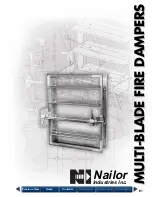
2
| Round fire damper manual 02/2021
SOLID AIR ®
CLIMATE SOLUTIONS
•
T +31 598 36 12 21
•
www.solid-air.com
•
1. Product overview
Fire dampers FDC are used for prevention of
fire spread trough the ventilation ducts and
between fire sections. Fire dampers consist of
cylindrical casing, calcium silicate damper blade,
damper blade mechanism outside of the airflow
and a manual, electromagnetic or electric
actuator.
Fire damper casing is made out of galvanized
steel sheet. Variants produced from stainless
steel and powder coated steel are also available.
Calcium silicate blade is equipped with brass
bearings and seals made out of polyurethane
and elastomer rubber. Fire dampers FDC25
are produced up to size d315 and have 25 mm
thick damper blade. Fire dampers FDC40 are
produced in sizes from d355 till d800 and have
40 mm thick damper blade. FDC25 fire dampers
are equipped with R25 manual mechanism and
FDC40 fire dampers are equipped with R40
manual mechanism.
Manual spring return mechanism is equipped
with thermal fuse that is triggered automatically
when the temperature inside the duct reaches
72 °C. It can also be activated manually by the
push of the button on the mechanism.
Additional equipment for manual mechanism
include end contact switches for damper
position signalling. Electromagnetic
actuators feature spring return mechanism
with electromagnet for remote activation.
Additional equipment for electromagnetic
mechanism include end contact switches for
damper position signalling. Rearming of the
electromagnetic actuator is manual.
Fire dampers with electric actuators are
equipped with Belimo actuator drives in 24 V
or 230 V versions. Activation of fire dampers
equipped with electric drives can be via 72 °C or
95 °C thermal fuse or remotely via control signal.
Rearming of the electric fire damper can also
be done remotely via control signal. All electric
actuators are equipped with end switches for
position signalling.
ATEX rated versions of fire dampers can be
delivered with Schischek 24 V / 230 V electric
actuators that are rated for installation in
explosive atmosphere areas. All fire dampers are
tested according to the EN 1751 for airtightness
and retain class 2 leakage on the closed damper
blade and class C on the casing air leakage.




















